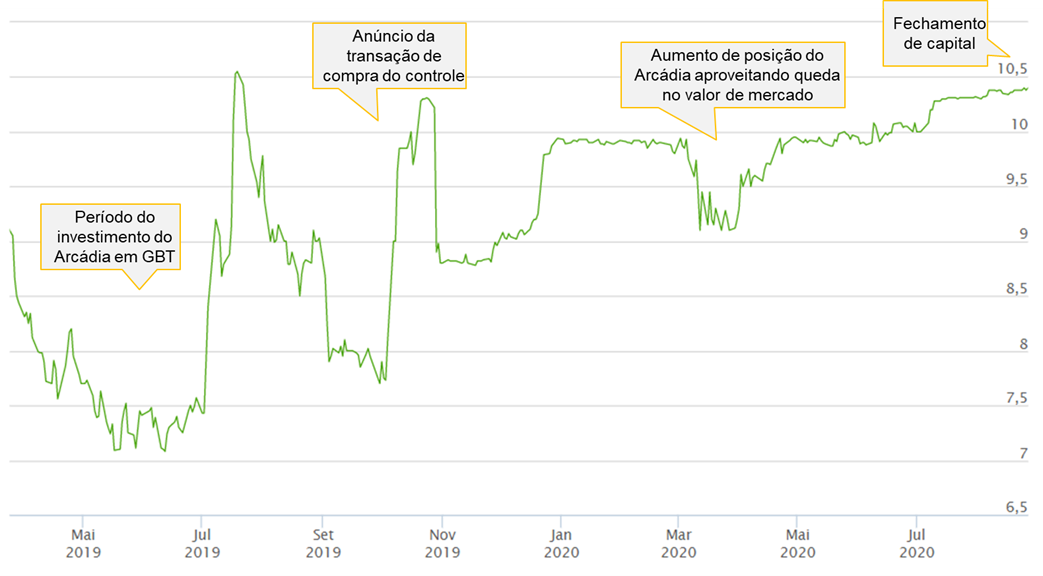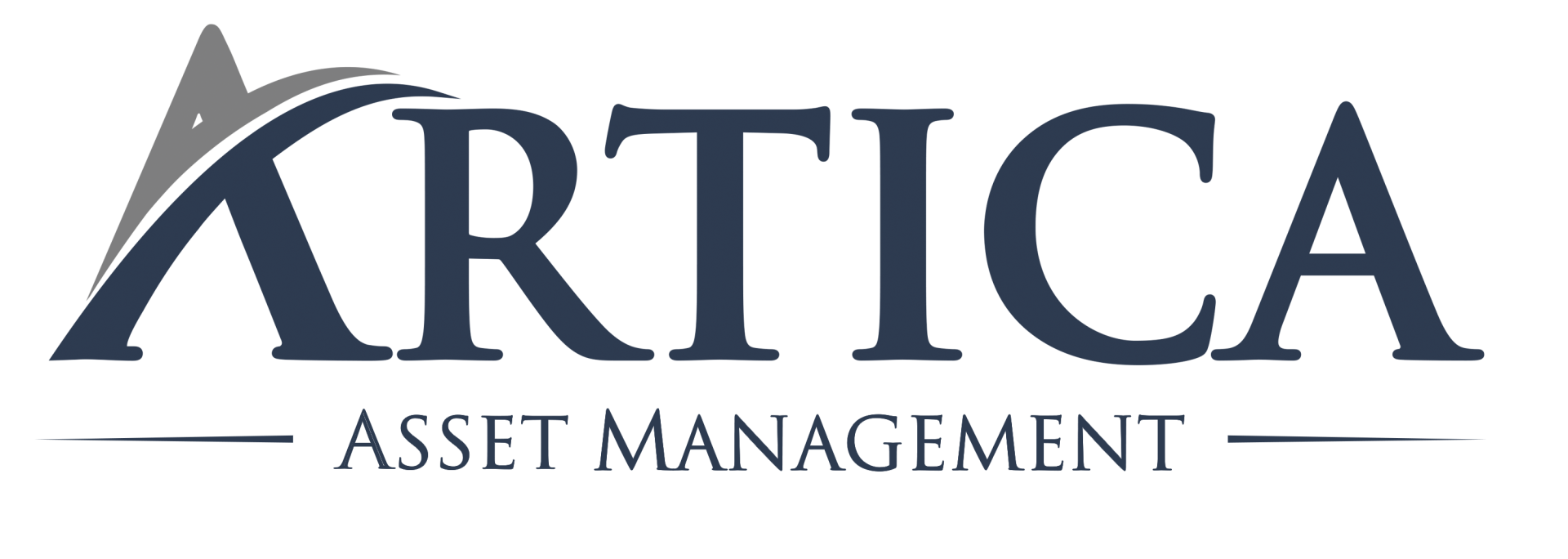dear investors,
For this month's letter, we will share a recent Arcádia case, which was the investment in Grupo Biotoscana (GBT).
GBT was a relevant portfolio investment from mid-2019 until our exit from the position in August 2020, when the company carried out a public offering to go private. It was an investment of just over a year that showed an appreciation of 29%, compared to 6-8% for Ibovespa in the same period.
This is an interesting case because we divided it into 2 phases with different analysis characteristics. The first phase corresponded to the entry period until October 2019, when it was officially announced that control of the company would be sold. At this stage, the investment analysis was more focused on the company's fundamentals, similar to the other analyzes we carried out. And the second phase corresponded to the period from October 2019 until our departure in August 2020. In this second phase, the investment had arbitrage characteristics.
Below, we detail our investment process in the company, with emphasis on the arbitration phase.
Company context and initial investment:
Grupo Biotoscana (GBT) sells highly complex medicines to treat diseases such as cancer, AIDS and Hepatitis C. The company was born from a project to consolidate the sector in Latin America, promoted by the private equity fund Advent. 4 companies were acquired to form the group: Biotoscana (Colombia, 2011), United Medical (Brazil, 2014), LKM (Argentina, 2015) and DOSA (Argentina, 2017).
Unlike other pharmaceutical companies, GBT has a business model that requires little investment in R&D. Instead of developing drugs, the company buys medicine marketing licenses from international pharmaceutical groups that do not have distribution strength in Latin America. Once the licenses have been purchased, the company is responsible for obtaining the necessary regulatory approvals for each medicine and for its distribution, marketing and after-sales.
If well executed, the company's business model allows for high returns, through the combination of purchasing licenses for good molecules at attractive prices with the low need for investment in research. There are, however, two problems with the model. The first is that the company only owns the license to sell the drug for a specific period, and not the drug itself. Therefore, the company always runs the risk of pharmaceutical companies not renewing licensing contracts. The second is that the adoption cycle of molecules can be quite long. After purchasing the molecules, the company takes an average of 1-2 years to obtain the necessary regulatory approvals and another 5-6 years of product maturation until it is widely adopted by the market and reaches its potential sales peak. Therefore, it is possible for the company to make investments that take years before their results begin to be reflected in their financial statements.
These problems converged into poor stock returns in the first two years after the IPO. The company held its IPO in 2017 with the share price at R$ 26.50 and traded close to R$ 7.00 in 2019, a drop of 73%.
The main reasons explaining this drop were: (1) the IPO price assumed the execution of a very challenging business plan; (2) in 2018, GBT lost a major drug contract that represented 15% of its revenues (the contract was with Actelion and was not renewed after the company was acquired by Johnson & Johnson); (3) Argentina (an important region in which GBT operates) entered an economic crisis, which did not help the company's results. The fall in the share price made the company discredited by the market and, in our opinion, provided a good entry window.
Graph 1 – GBT price per share and main milestones (part 1)

Our main reason for believing that the stock had become cheap was that GBT had a pipeline of recently launched molecules with enormous sales potential, but which were still in the maturing phase and did not have a significant impact on the company's results. It was a thesis that would take longer to materialize, but we believed it had a great margin of safety and, therefore, we decided to make the investment. This was phase 1 of the case.
Post-acquisition analysis:
A few months after the investment, the sale of control of GBT to the Canadian group Knight Therapeutics was announced. In fact, we had already considered this hypothesis in the initial discussions given that M&As are quite common in the sector, and Advent was already completing 8 years since its initial investment, so the deadline for its divestment was approaching¹.
In situations like these, the need to change the focus of the analysis becomes clear. Instead of seeking to understand the fundamentals and prospects of the business, it becomes more important to understand the characteristics of the transaction and its impacts on minority shareholders. In particular, the problem becomes finding the fair share price today given the following variables: (1) the probability that the transaction will actually be completed; (2) the price of the transaction and, consequently, the price that will be paid to us, minority shareholders and (3) the deadline for such payment to be made. Below we detail each of these variables:
1. Probability of closing the transaction: At this point, our background in M&A allowed for a difference in the analysis. In situations like these, after the transaction is announced, it is common for some precedent conditions to be met until the transaction is completed. Common conditions precedent are:
The. Approval from anti-trust bodies: In this case, as Knight did not have a presence in Latin America (GBT's region of operation), the transaction did not need to be submitted to anti-trust bodies, eliminating this potential risk.
B. Obtaining financing: Transaction financing can be a major bottleneck in some cases, but it was not a risk in this one. When announcing the transaction, it was said that it would be financed with Knight's own cash resources, and when evaluating the company's balance sheet, we saw that it had more than enough resources to complete the transaction, even in an adverse scenario, which was the occurred with the Covid-19 crisis.
w. Approval from important company stakeholders: This point could be critical, as GBT had commercial relationships with several pharmaceutical companies that owned the drugs licensed by the company and they would probably have to approve the sale. However, in our experience, we consider that GBT and Knight would be unlikely to announce the transaction without such approvals being obtained.
In addition to the transaction being completed, we also had to worry about ensuring that we, as minority shareholders, would also benefit from the sale. In this case, the protection of minority shareholders was guaranteed by GBT's bylaws, which established the right to tag along² for minority shareholders under the same conditions as controlling shareholders. In other words, in the event of a sale of control, the buyer would have to extend the offer made to the controlling shareholders to all other shareholders of the company.
2. Price paid to minority shareholders: The value of R$ 10.15 per share was proposed, which would be adjusted by the Selic rate until the date of completion of the delisting³. By the way, a value very close to what we conservatively estimated as the intrinsic value of the business in our internal analyses.
3. Payment period: Regarding the payment period, the history of similar transactions in Brazil shows that the period for delisting varies between 8-12 months after the completion of the acquisition of control. Therefore, we expected the deal to be concluded between July and November 2020.
Summarizing the 3 points above, we had the scenario of a transaction with a very high probability of being completed, with a practically guaranteed payment of R$ 10.15 / share (adjusted by Selic) in a relatively short period. It was up to us to monitor the share price in the market and determine the best times to increase or reduce the position.
An opportunity to increase the position appeared in March 2020, during a period of greater uncertainty due to the Covid-19 crisis. At the time, the share was traded at R$ 9.00 and we saw a clear asymmetry in the market. Considering the value of R$ 10.40 that was received in Aug/2020, we were faced with an opportunity that allowed a return of 16% in 5 months, which corresponds to an annualized return of 41% per year. This compared to a Selic rate of 4.25% at the time. We made a significant investment and the position represented up to 20% of the portfolio.
In a short time, the distortion was corrected and the share returned to trading close to R$ 10.00, enabling a quick return and with a very low level of risk for Arcadia.
Graph 2 – GBT price per share and main milestones (part 2)

Result:
As mentioned at the beginning of the text, investment in GBT showed an appreciation of 29% compared to 6-8% for Ibovespa in the period.
In our opinion, this case brings two important lessons. The first is that the market can overreact to bad news about a company, to the point that it becomes discredited and provides a buying opportunity. The second is that, if well analyzed and understood, delisting situations can provide great arbitrage opportunities that offer an interesting level of return, with a low level of risk. At Arcádia, we are always monitoring the market for such situations.
¹ Investments made by private equity funds have an average term of 5 to 7 years.
² Tag along is a mechanism to protect a company's minority shareholders. It guarantees such shareholders the right to sell their stake in the company if it is sold to a third party.
³ In the material fact that presented the delisting, the company presented two options to minority shareholders. The first was a fixed price of R$ 8.77 and variable installments paid over 3 years that could reach a total of R$ 2.16, and the second was a fixed price of R$ 10.15 per share. The second alternative was the one we chose and, for simplification purposes, it is what we focus on in the text.


